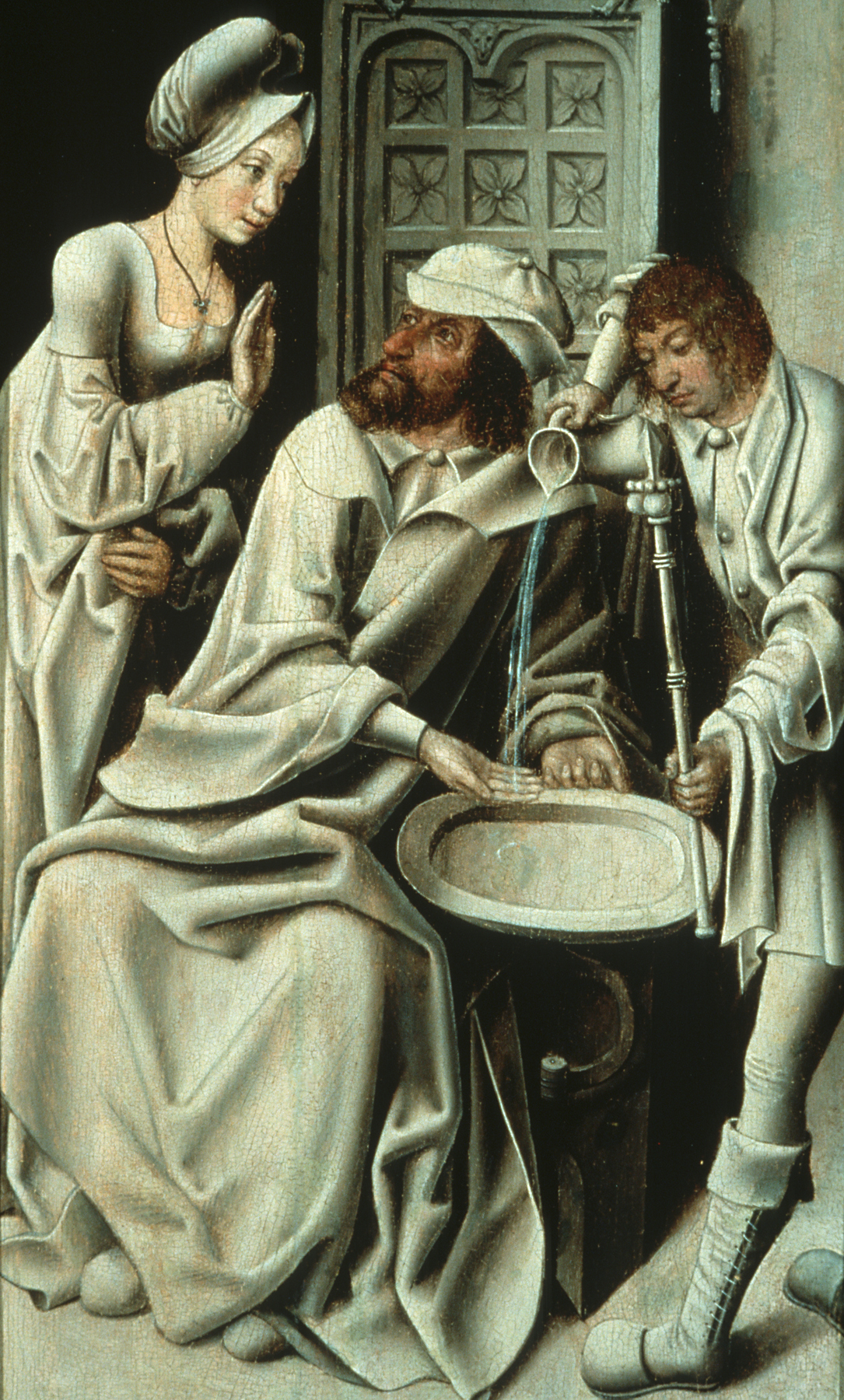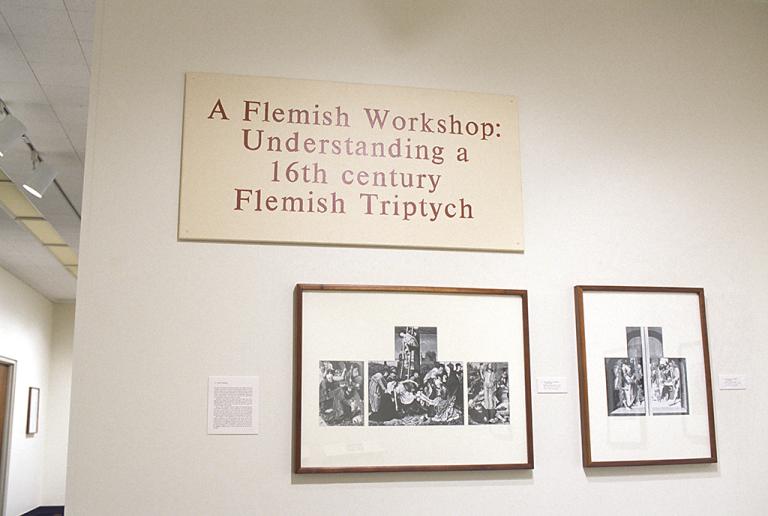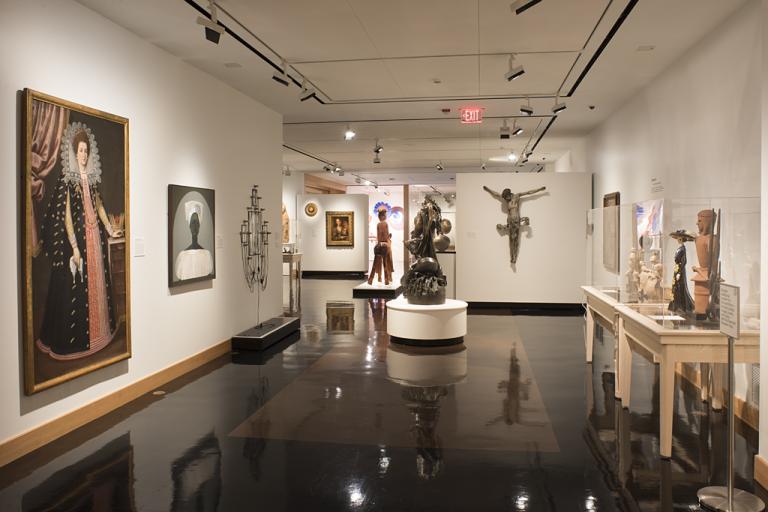Scenes from the Passion, Master of Frankfurt Workshop
Artwork Overview

If you wish to reproduce this image, please submit an image request
Images
Label texts
The Master of Frankfurt is the name traditionally given to an anonymous artist responsible for two altarpieces that were made for patrons in Frankfurt am Main, in Germany. However, the artist actually worked in Antwerp. In the early 16th century, when the Master of Frankfurt’s shop was active, Antwerp was becoming one of Europe’s greatest economic and artistic centers. This rapid growth of wealth and commerce changed the ways that paintings were made and sold. For example, some workshops, such as that of the Master of Frankfurt, made paintings to be sold on the open market, rather than having been commissioned by a specific donor.
This altarpiece has evidence of this change in the market: the shields of the exterior wings have been left blank, perhaps so the owner could have his or her own coat of arms painted in. There are many “quotations” from famous 15th-century workshops. The pattern on the gold brocade worn by Mary Magdalene (the woman kneeling at the right of the central panel) is identical, in size and in form, to brocades on many other paintings from the shop of the Master of Frankfurt and was probably made with the help of a stencil, which would have streamlined production.
This colorful triptych consists of a central panel and two side panels, or wings, that fold over the central panel. The reverse sides of the wings are painted in grayscale and would have been visible on most occasions, except when the triptych was opened for Sunday worship or feast days. The altarpiece presents the Passion—the final events of Jesus’ life—in the form of a continuous narrative that begins on the exteriors of the wings.
This altarpiece reveals changes in the Antwerp economy that allowed workshops to produce paintings for sale on the open market rather than depending exclusively on private commissions. The shields of the exterior wings have been left blank, perhaps so the owner’s coat of arms could be added. The pattern on the gold brocade worn by Mary Magdalene (the woman kneeling at the right of the central panel) is identical in size and form to brocades on many other paintings from the shop of the Master of Frankfurt and was probably made with the help of a stencil, which would have streamlined production.
This colorful triptych consists of a central panel and two side panels, or wings, that fold over the central panel. The reverse sides of the wings are painted in grayscale and would have been visible on most occasions, except when the triptych was opened for Sunday worship or feast days. The altarpiece presents the Passion—the final events of Jesus’ life—in the form of a continuous narrative that begins on the exteriors of the wings.
This altarpiece reveals changes in the Antwerp economy that allowed workshops to produce paintings for sale on the open market rather than depending exclusively on private commissions. The shields of the exterior wings have been left blank, perhaps so the owner’s coat of arms could be added. The pattern on the gold brocade worn by Mary Magdalene (the woman kneeling at the right of the central panel) is identical in size and form to brocades on many other paintings from the shop of the Master of Frankfurt and was probably made with the help of a stencil, which would have streamlined production.
The Master of Frankfurt is the name traditionally given to an anonymous artist responsible for two altarpieces that were made for patrons in Frankfurt am Main, in Germany. However, the artist actually worked in Antwerp. In the early 16th century, when the Master of Frankfurt’s shop was active, Antwerp was becoming one of Europe’s greatest economic and artistic centers. This rapid growth of wealth and commerce changed the ways that paintings were made and sold. For example, some workshops, such as that of the Master of Frankfurt, made paintings to be sold on the open market, rather than having been commissioned by a specific donor.
This altarpiece has evidence of this change in the market: the shields of the exterior wings have been left blank, perhaps so the owner could have his or her own coat of arms painted in. There are many “quotations” from famous 15th-century workshops. The pattern on the gold brocade worn by Mary Magdalene (the woman kneeling at the right of the central panel) is identical, in size and in form, to brocades on many other paintings from the shop of the Master of Frankfurt and was probably made with the help of a stencil, which would have streamlined production.
Although the anonymous artist whose workshop produced this altarpiece is known as the “Master of Frankfurt,” he actually worked in Antwerp. This painting is a triptych, a work of art comprised of three hinged panels that was typical in Northern Europe. The wings were kept closed except on Sundays and feast days, when they were opened to reveal the colorfully-painted interior. The painting presents Christ’s Passion as a continuous narrative that begins on the exteriors of the wings with scenes of Christ’s encounter with Pilate in semi-grisaille, or partial greyscale. On the interior, the rhythmic arrangement of figures combines with the rolling landscape beyond to draw the viewer through the progression from the Carrying of the Cross through the Lamentation and, finally, to the Resurrection. These scenes include many quotations drawn from the works of illustrious 15th-century artists, including Rogier van der Weyden, Hans Holbein the Elder, and Martin Schongauer.
Exhibition Label:
"Giorgio Vasari and Court Culture in Late Renaissance Italy," Sep-2012, Sally Cornelison and Susan Earle
Although the anonymous artist whose workshop produced this altarpiece is known as the “Master of Frankfurt,” he actually worked in Antwerp. This painting is a triptych, a work of art comprised of three hinged panels that was typical in Northern Europe. The wings were kept closed except on Sundays and feast days, when they were opened to reveal the colorfully-painted interior. The painting presents Christ’s Passion as a continuous narrative that begins on the exteriors of the wings with scenes of Christ’s encounter with Pilate in semi-grisaille, or partial greyscale. On the interior, the rhythmic arrangement of figures combines with the rolling landscape beyond to draw the viewer through the progression from the Carrying of the Cross through the Lamentation and, finally, to the Resurrection. These scenes include many quotations drawn from the works of illustrious 15th-century artists, including Rogier van der Weyden, Hans Holbein the Elder, and Martin Schongauer.
Exhibition Label:
"Corpus," Apr-2012, Steve Goddard
The “Master of Frankfurt” is the name traditionally given to an anonymous artist responsible for two altarpieces that were made for patrons in Frankfurt am Main, in Germany. However, the artist actually worked in Antwerp. In the early 16th century, when the Master of Frankfurt’s shop was active, Antwerp was becoming one of Europe’s greatest economic
and artistic centers. This rapid growth of wealth
and commerce changed the ways that paintings were made and sold. For example, some workshops, such as that of the Master of Frankfurt, made paintings to be sold on the open market, rather than having been commissioned by a specific donor.
This altarpiece has evidence of this change in the market: the shields of the exterior wings have been left blank, perhaps so the owner could have his or her own coat of arms painted in. There are many “quotations” from famous 15th-century workshops. The pattern on the gold brocade worn by Mary Magdalene (the woman kneeling at the right of the central panel) is identical, in size and in form, to brocades on many other paintings from the shop of the Master of Frankfurt and was probably made with the help of a stencil, which would have streamlined production.
Label Sep-2009:
The “Master of Frankfurt” is the name traditionally given to an anonymous artist responsible for two altarpieces that were made for patrons in Frankfurt am Main, in Germany. However, the artist actually worked in Antwerp, a city in the Southern Netherlands (modern Belgium). In the early sixteenth century, when the Master of Frankfurt’s shop was active, Antwerp was becoming one of Europe’s greatest economic and artistic centers, which changed the ways that paintings were made and sold. We can see some of these changes in this altarpiece. They suggest a workshop, probably with several artists, in which paintings were being made rapidly, sometimes for an open market (as opposed to having been commissioned by a specific donor). Here are some of the clues: the shields of the exterior wings have been left blank, perhaps so the owner could have his or her own coat of arms painted in; there are many “quotations” from famous fifteenth-century workshops, such as those of Rogier van der Weyden and Hans Holbein the Elder; the pattern on the gold brocade worn by Mary Magdalene (the woman kneeling at the right of the central panel) is identical, in size and in form, to brocades on many other paintings from the shop of the Master of Frankfurt and was probably made with the help of a stencil.
At some point, probably during the late nineteenth century, someone made significant physical changes to this altarpiece. It was originally a triptych with a large central panel and two hinged wings that could close over the central panel, revealing the paintings on the back of the wings. Someone removed the hinges and made the three panels of the open altarpiece into a static group. They also sawed the paintings off of the backs of the wings so that all five painted surfaces of the altarpiece could be seen at once.
Exhibitions
Susan Earle, curator
Kate Meyer, curator
Celka Straughn, curator
Kate Meyer, curator
Celka Straughn, curator








